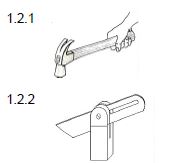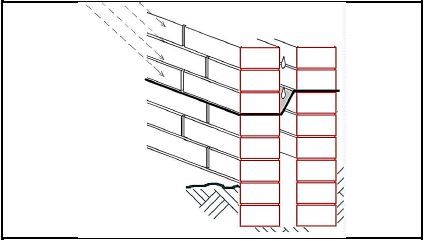CIVIL TECHNOLOGY PAPER GRADE 12 QUESTIONS - NSC PAST PAPERS AND MEMOS SEPTEMBER 2016
Share via Whatsapp Join our WhatsApp Group Join our Telegram GroupCIVIL TECHNOLOGY PAPER
GRADE 12
NSC PAST PAPERS AND MEMOS
SEPTEMBER 2016
QUESTIONS
REQUIREMENTS:
- ANSWER BOOK
- Drawing instruments
- A non-programmable calculator
INSTRUCTIONS AND INFORMATION
- This question paper consists of SIX questions.
- ALL questions are COMPULSORY.
- . Answer each question as a whole. Do NOT separate sub-questions
- Start EACH question on a NEW page.
- Sketches may be used to illustrate your answers.
- ALL calculations and written answers must be done in the ANSWER BOOK.
- Use the mark allocation as a guide for the length of your answer.
- Drawings and sketches must be fully-dimensioned and neatly finished off with titles and labels to conform to SANS (SABS) Recommended Practice for Building Drawings.
- For the purpose of this examination, the size of a brick should be taken as 220 mm x 110 mm x 75 mm.
- Use your discretion where dimensions and/or details have been omitted.
- Answer QUESTION 5.2 and QUESTION 6.1 on the ANSWER SHEETS that is provided.
QUESTION 1: CONSTRUCTION PROCESSES
1.1 FIGURE 1.1 shows a shoring that must support the ground in an excavation. Answer the following questions with regard to the shoring in FIGURE 1.1. 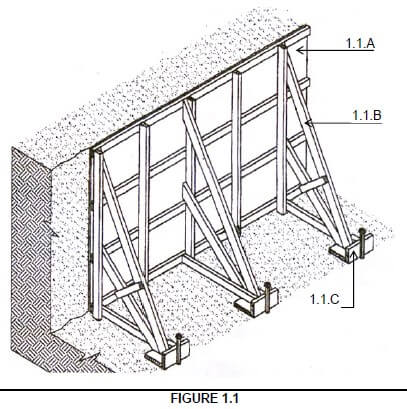
1.1.1 What is this type of shoring called? (1)
1.1.2 Name the parts 1.1.A to 1.1.C. (3)
1.2 Name the following tools and name ONE use of each: 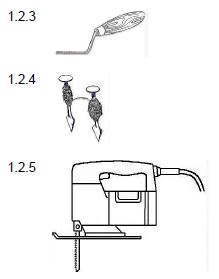
1.3 Briefly motivate why the blade of the portable power saw must come to a standstill, before it is put down. (2)
1.4 FIGURE 1.4 shows the brickwork for an outer wall. Answer the following questions with regard to the brickwork in FIGURE 1.4.
FIGURE 1.4
1.4.1 What is this type of wall construction called? (1)
1.4.2 Name THREE advantages of this type of wall construction. (3 x 1) (3)
1.4.3 Briefly motivate why each third vertical mortar joint above the damp-proof layer must be left open. (2)
1.5 FIGURE 1.5 shows the uncompleted fixing of a roof truss on a wall.
Answer the following questions with regard to the construction in FIGURE 1.5. 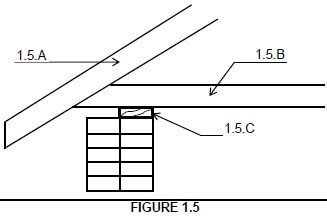
1.5.1 Name the parts 1.5.A to 1.5.C. (3)
1.5.2 Briefly describe the purpose of part 1.5.C. (2)
1.5.4 Identify the wrong installing process of the roof truss in FIGURE 1.5 and describe how the correct installing should be done.
Sketches can be used to illustrate the correct installing. (3)
[30]
QUESTION 2: ADVANCED CONSTRUCTION PROCESSES
2.1 Briefly describe the purpose of a lintel. (2)
2.2 Name the THREE main components used in the manufacturing of glass. (3 x 1) (3)
2.3 Make a neat sketch to illustrate the construction of a pile foundation. (3)
2.4 Briefly motivate why foundations must be cast below the ground surface. (2)
2.5 Name FOUR factors that will have an influence in the choice of the correct type of foundation. (4 x 1) (4)
2.6 Briefly describe the purpose of the wearing course under a concrete floor. (3)
2.7
2.7.1 Describe THREE requirements with which steel reinforcement for concrete must comply. (3 x 1) (3)
2.7.2 Name THREE types of safety wear you would buy for workers working with steel reinforcements. (3 x 1) (3)
2.8 Indicate whether the following statements with regard to formwork construction are TRUE or FALSE. Write only the word ‘true’ or ‘false’ next to the number in the ANSWER BOOK.
2.8.1 The moisture content of the boards must be at least 30%. (1)
2.8.2 Joints must be left open to allow shrinking and expansion of the boards. (1)
2.8.3 G-clamps are used to keep together the formwork boards for large construction. (1)
2.8.4 The purpose of the yoke is to seal the formwork. (1)
2.8.5 Laminated formwork boards give a better finish to concrete. (1)
2.8.6 Mould oil is applied to the formwork boards to prevent the concrete from binding with the formwork. (1)
2.8.7 Old and new formwork material must not be used together. (1)
2.8.8 The spacing of the clamps and yokes is also determined by the type of concrete mix. (1)
2.9 Answer the following questions with regard to the arch construction in FIGURE 2.9. 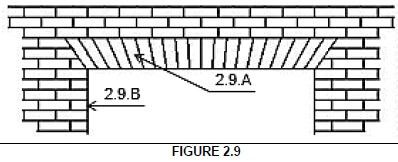
2.9.1 What is this type of arch called? (1)
2.9.2 Briefly motivate why the middle of the arch is made slightly higher. (2)
2.9.3 Name parts 2.9.A and 2.9.B. (2)
2.10 Briefly describe the purpose of the gusset plates in steel frame structures. (2)
2.11 What are the standard depths of the following kitchen cupboard parts?
2.11.1 Wall unit (1)
2.11.2 Floor unit (1)
[40]
QUESTION 3: CIVIL SERVICES
3.1 FIGURE 3.1 shows the municipal water supply to a site. Answer the following questions with regard to the system. 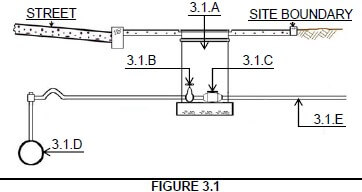
3.1.1 What is the structure 3.1.A called? (1)
3.1.2 Name parts 3.1.B to 3.1.E. (4)
3.1.3 What is the section size of part 3.1.E? (1)
3.1.4 Who is responsible for the system from point 3.1.D to 3.1.A? (1)
3.2 Briefly motivate why a drip tray must be installed underneath a geyser. (2)
3.3 Briefly motivate why the sun collectors in the southern hemisphere must be installed at true north. (2)
3.4 Answer the following questions with regard to the valve in FIGURE 3.4. 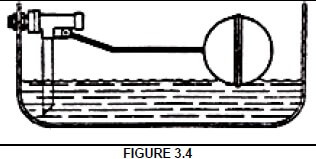
3.4.1 What is the valve in FIGURE 3.4 called? (1)
3.4.2 Name TWO positions in a house water supply system where this valve must be installed. (2 x 1) (2)
3.5 Identify the correct answer in each of the following descriptions of a septic tank. Write only the correct answer next to the question number in the ANSWER BOOK.
3.5.1 It is an impermeable UNDERGROUND / ABOVE-GROUND structure. (1)
3.5.2 It consist of TWO / FOUR rooms. (1)
3.5.3 The heavier parts of the inflow water FLOAT / SETTLE DOWN. (1)
3.5.4 The organic matter is decomposed by the action of CHEMICAL PROCESSES / ANAEROBIC BACTERIA action. (1)
3.6 What is the purpose of the ball test for drains? (1)
3.7 What is the minimum depth of drains underneath ground surface? (1)
3.8 Name THREE positions in a drain system where access openings must be installed. (3 x 1) (3)
3.9 Make a neat sketch to illustrate a P-type drain trap. Also indicate the water level inside the trap. (4)
3.10 Which tool is used to clear blocked drains? (1)
3.11 Name TWO advantages of wind turbines for supplying electricity. (2 x 1) (2)
[30]
QUESTION 4: MATERIALS AND QUANTITIES
4.1 Name THREE properties of coal tar creosote for wood preservation. (3 x 1) (3)
4.2 Wood must be seasoned to decrease the moisture content of it. Answer the following questions with regard to the seasoning method illustrated in FIGURE 4.2. 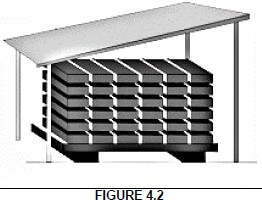
4.2.1 What is this seasoning method called? (1)
4.2.2 Briefly motivate why the bottom timber must be approximately 600 mm above ground. (2)
4.2.3 Name TWO requirements of the foundation for this seasoning method. (2)
4.3 Name FOUR advantages of using PVC as drain pipes. (4 x 1) (4)
4.4 Briefly describe what plywood is. (3)
4.5 Indicate whether the following statements with regard to materials are TRUE or FALSE. Write only ‘true’ or ‘false’ next to the number in the ANSWER BOOK.
4.5.1 Fibre board is used in the manufacturing of table tops. (1)
4.5.2 The cube test is used to test the compressive stress of wood. (1)
4.5.3 A cornice is installed between the ceiling and the wall. (1)
4.5.4 The compacting of concrete is done 28 days after it has been cast. (1)
4.5.5 Aluminium is a light metal. (1)
4.6 FIGURE 4.6 shows the foundation strips for a building. The foundations are 700 mm wide and 200 mm thick and a concrete mix of 1 : 3 : 4 is used. The centre line measurement of the building is 31,6 m and the total volume concrete needed for the foundation is 4,424 m³.
Determine the following quantities for the concrete mix: 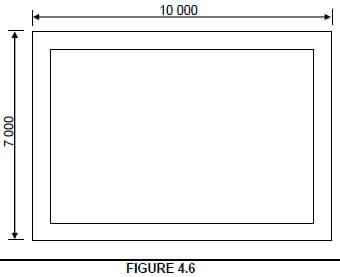
4.6.1 Calculate the volume of sand needed (3) 4.6.2 Calculate the volume of stone needed (3)
4.6.3 Calculate the number of bags of cement needed, if the content of a bag of cement is 0,033 m³ (4)
[30]
QUESTION 5: APPLIED MECHANICS
5.1 Calculate the centroid of the body in FIGURE 5.1 from point P. (4)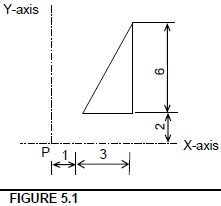
5.2 FIGURE 5.2, on ANSWER SHEET A, shows the space diagram for a roof truss. Determine graphically, on ANSWER SHEET A by drawing the force diagram and completing the table, the size and nature of the forces in the parts of the truss. (18) 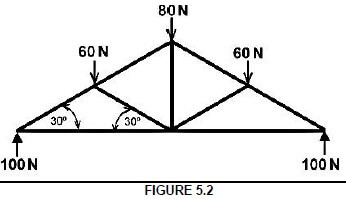
5.3 FIGURE 5.3 shows a beam with point loads. Calculate the reaction forces of the supports A and B. (8)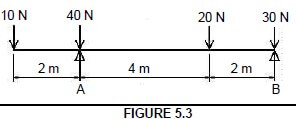
[30]
QUESTION 6: GRAPHICS AND COMMUNICATION
6.1 FIGURE 6.1 on ANSWER SHEET B shows the outer lines of a structure which must be built on a site. Draw the site plan on scale 1 : 200 on ANSWER SHEET B so that the structure is in the middle of the site. The site plan must comply with the following requirements:
6.1.1 Site size is 20 m wide from east to west and 30 m long from south to north (2)
6.1.2 Pavement of 2 m and the street of 6 m on the south side (4)
6.1.3 Building boundaries are 2 m on the east, north and west sides and 4 m on the south side (4)
6.1.4 3 m wide entrance to the site (2)
6.1.5 Datum level in the north-west corner of the site (2) Also draw the roof plan on the structure and indicate the following:
6.1.6 Overhang of 400 mm (2)
6.1.7 Hipped end at the north end (2)
6.1.8 American cable-end at the south end (3)
6.1.9 Ridge (1) Indicate the following measurements:
6.1.10 Length and width of the site (4)
6.1.11 South and west building boundaries (2)
6.2 Make neat sketches to illustrate the following symbols on a floor plan:
6.2.1 Water meter (2)
6.2.2 Vent pipe (2)
6.2.3 Bath (2)
6.2.4 Water closet (2)
6.2.5 Sink (2)
6.2.6 Power point (2)
[40]
TOTAL: 200
ANSWER SHEET A | CIVIL TECHNOLOGY | NAME: |
QUESTION 5.2 (18)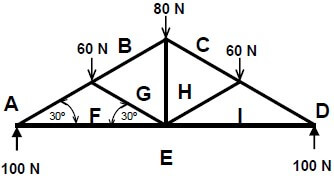
SPACE DIAGRAM:
SCALE: 2 mm = 1 N
| PART | STRUT ↔ | TIE
|
| AF | ||
| BG | ||
| CH | ||
| DI | ||
| EI | ||
| EF | ||
| FG | ||
| GH | ||
| HI |
ANSWER SHEET B | CIVIL TECHNOLOGY | NAME: |
QUESTION 6.1 (28)
|

FORMULA SHEET
IMPORTANT ABBREVIATIONS
SYMBOL | DESCRIPTION | SYMBOL | DESCRIPTION | SYMBOL | DESCRIPTION |
G | Centre of gravity | h | Height | d | Diameter |
C | Centroid | b | Breadth/Width | r | Radius |
L | Length | s | Side | A | Area |
| π | Pi = 22/7 = 3,142 | ∅ | Diameter | V | Volume |
FORMULAE
AREA OF | FORMULA (in words) | FORMULA (in symbols) | FORMULA FOR THE POSITION OF CENTROIDS | |
X-axis | Y-axis | |||
Square | Length x Breadth | l x b | b/2 | b/2 |
Rectangle | Length x Breadth | l x b | I/2 | b/2 |
Right-angled triangle | ½ x base x height | ½b x h | b/3 | h/3 |
Equilateral triangle/Pyramid | ½ x base x height | ½b x h | b/2 | h/3 |
Circle | π x radius x radius | πr2 | Centroid is in the centre | |
Circle | π x diameter x diameter divided by 4 | πd2 | ||
Semi-circle | π x radius r x radius divided by 2 | πr2 | Centroid is 0,424r on the centre line | |
Position of centroid = (A1 × d) ± (A2 × d)
Total area
